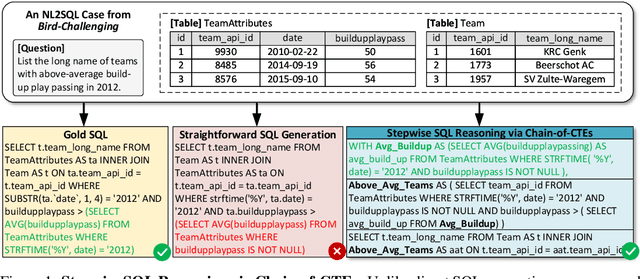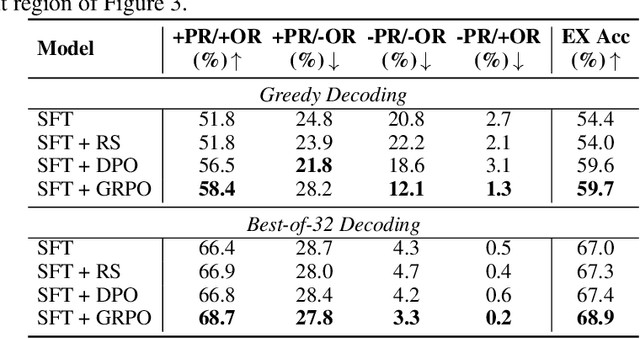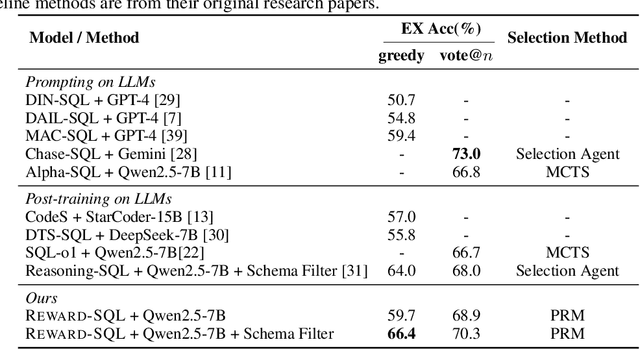Yuyu Luo
VisJudge-Bench: Aesthetics and Quality Assessment of Visualizations
Oct 25, 2025Abstract:Visualization, a domain-specific yet widely used form of imagery, is an effective way to turn complex datasets into intuitive insights, and its value depends on whether data are faithfully represented, clearly communicated, and aesthetically designed. However, evaluating visualization quality is challenging: unlike natural images, it requires simultaneous judgment across data encoding accuracy, information expressiveness, and visual aesthetics. Although multimodal large language models (MLLMs) have shown promising performance in aesthetic assessment of natural images, no systematic benchmark exists for measuring their capabilities in evaluating visualizations. To address this, we propose VisJudge-Bench, the first comprehensive benchmark for evaluating MLLMs' performance in assessing visualization aesthetics and quality. It contains 3,090 expert-annotated samples from real-world scenarios, covering single visualizations, multiple visualizations, and dashboards across 32 chart types. Systematic testing on this benchmark reveals that even the most advanced MLLMs (such as GPT-5) still exhibit significant gaps compared to human experts in judgment, with a Mean Absolute Error (MAE) of 0.551 and a correlation with human ratings of only 0.429. To address this issue, we propose VisJudge, a model specifically designed for visualization aesthetics and quality assessment. Experimental results demonstrate that VisJudge significantly narrows the gap with human judgment, reducing the MAE to 0.442 (a 19.8% reduction) and increasing the consistency with human experts to 0.681 (a 58.7% improvement) compared to GPT-5. The benchmark is available at https://github.com/HKUSTDial/VisJudgeBench.
ChartMark: A Structured Grammar for Chart Annotation
Jul 29, 2025Abstract:Chart annotations enhance visualization accessibility but suffer from fragmented, non-standardized representations that limit cross-platform reuse. We propose ChartMark, a structured grammar that separates annotation semantics from visualization implementations. ChartMark features a hierarchical framework mapping onto annotation dimensions (e.g., task, chart context), supporting both abstract intents and precise visual details. Our toolkit demonstrates converting ChartMark specifications into Vega-Lite visualizations, highlighting its flexibility, expressiveness, and practical applicability.
TransXSSM: A Hybrid Transformer State Space Model with Unified Rotary Position Embedding
Jun 12, 2025Abstract:Transformers exhibit proficiency in capturing long-range dependencies, whereas State Space Models (SSMs) facilitate linear-time sequence modeling. Notwithstanding their synergistic potential, the integration of these architectures presents a significant challenge, primarily attributable to a fundamental incongruity in their respective positional encoding mechanisms: Transformers rely on explicit Rotary Position Embeddings (RoPE), while SSMs leverage implicit positional representations via convolutions. This divergence often precipitates discontinuities and suboptimal performance. To address this impediment, we propose a unified rotary position embedding (Unified RoPE) methodology, thereby establishing a consistent positional encoding framework for both self-attention and state-space components. Using this Unified RoPE, we introduce TransXSSM, a hybrid architecture that coherently integrates the Transformer and SSM layers under this unified positional encoding scheme. At a 4K sequence length, TransXSSM exhibits training and inference speeds that are 42.3\% and 29.5\% faster, respectively, relative to standard Transformer models. It also delivers higher accuracy: under comparable settings, it surpasses a Transformer baseline by over 4\% on language modeling benchmarks.TransXSSM furthermore scales more effectively: TransXSSM-1.3B gains 7.22\% in average accuracy over its 320M version (versus about 6\% gains for equivalent Transformers or SSMs). Our results show that unified positional encoding resolves positional incompatibility in hybrid models, enabling efficient, high-performance long-context modeling.
Concise Reasoning, Big Gains: Pruning Long Reasoning Trace with Difficulty-Aware Prompting
May 26, 2025Abstract:Existing chain-of-thought (CoT) distillation methods can effectively transfer reasoning abilities to base models but suffer from two major limitations: excessive verbosity of reasoning traces and inadequate adaptability to problem difficulty. Long reasoning traces significantly increase inference costs, and uniform-length solutions prevent base models from learning adaptive reasoning strategies. To address these issues, we propose a difficulty-aware prompting (DAP) method to dynamically shorten reasoning traces without performance loss. In our approach, a large teacher model first judges each problem's difficulty and then rewrites its reasoning traces to an appropriate shorter length, yielding concise yet complete reasoning traces. Leveraging the DAP pipeline, we curate a distilled dataset called LiteCoT consisting of 100K concise reasoning examples, with solutions averaging only 720 tokens (an order of magnitude shorter than typical CoTs). Using LiteCoT, we distilled a new family of reasoning models called Liter (1.5B, 7B, and 32B) based on the Qwen2.5 architecture. Experiments show that a student model fine-tuned on just 100K of these difficulty-pruned CoT samples outperforms a model distilled on 800K original Long CoT samples, while significantly reducing training and inference costs. Our method also generalizes well: across 11 diverse benchmarks, the shorter difficulty-aware CoTs achieve equal or better accuracy than Long chains, using far fewer tokens. For example, on the challenging AIME24 exam, our approach reaches $74.2\%$ Pass@1 using only about 5K inference tokens, surpassing other methods that consume many more tokens. Our code and data are available at https://github.com/Evanwu1125/LiteCoT.
ChartCards: A Chart-Metadata Generation Framework for Multi-Task Chart Understanding
May 21, 2025Abstract:The emergence of Multi-modal Large Language Models (MLLMs) presents new opportunities for chart understanding. However, due to the fine-grained nature of these tasks, applying MLLMs typically requires large, high-quality datasets for task-specific fine-tuning, leading to high data collection and training costs. To address this, we propose ChartCards, a unified chart-metadata generation framework for multi-task chart understanding. ChartCards systematically synthesizes various chart information, including data tables, visualization code, visual elements, and multi-dimensional semantic captions. By structuring this information into organized metadata, ChartCards enables a single chart to support multiple downstream tasks, such as text-to-chart retrieval, chart summarization, chart-to-table conversion, chart description, and chart question answering. Using ChartCards, we further construct MetaChart, a large-scale high-quality dataset containing 10,862 data tables, 85K charts, and 170 K high-quality chart captions. We validate the dataset through qualitative crowdsourcing evaluations and quantitative fine-tuning experiments across various chart understanding tasks. Fine-tuning six different models on MetaChart resulted in an average performance improvement of 5% across all tasks. The most notable improvements are seen in text-to-chart retrieval and chart-to-table tasks, with Long-CLIP and Llama 3.2-11B achieving improvements of 17% and 28%, respectively.
Time Travel is Cheating: Going Live with DeepFund for Real-Time Fund Investment Benchmarking
May 16, 2025Abstract:Large Language Models (LLMs) have demonstrated notable capabilities across financial tasks, including financial report summarization, earnings call transcript analysis, and asset classification. However, their real-world effectiveness in managing complex fund investment remains inadequately assessed. A fundamental limitation of existing benchmarks for evaluating LLM-driven trading strategies is their reliance on historical back-testing, inadvertently enabling LLMs to "time travel"-leveraging future information embedded in their training corpora, thus resulting in possible information leakage and overly optimistic performance estimates. To address this issue, we introduce DeepFund, a live fund benchmark tool designed to rigorously evaluate LLM in real-time market conditions. Utilizing a multi-agent architecture, DeepFund connects directly with real-time stock market data-specifically data published after each model pretraining cutoff-to ensure fair and leakage-free evaluations. Empirical tests on nine flagship LLMs from leading global institutions across multiple investment dimensions-including ticker-level analysis, investment decision-making, portfolio management, and risk control-reveal significant practical challenges. Notably, even cutting-edge models such as DeepSeek-V3 and Claude-3.7-Sonnet incur net trading losses within DeepFund real-time evaluation environment, underscoring the present limitations of LLMs for active fund management. Our code is available at https://github.com/HKUSTDial/DeepFund.
Boosting Text-to-Chart Retrieval through Training with Synthesized Semantic Insights
May 15, 2025Abstract:Charts are crucial for data analysis and decision-making.Text-to-chart retrieval systems have become increasingly important for Business Intelligence (BI), where users need to find relevant charts that match their analytical needs. These needs can be categorized into precise queries that are well-specified and fuzzy queries that are more exploratory -- both require understanding the semantics and context of the charts. However, existing text-to-chart retrieval solutions often fail to capture the semantic content and contextual information of charts, primarily due to the lack of comprehensive metadata (or semantic insights). To address this limitation, we propose a training data development pipeline that automatically synthesizes hierarchical semantic insights for charts, covering visual patterns (visual-oriented), statistical properties (statistics-oriented), and practical applications (task-oriented), which produces 207,498 semantic insights for 69,166 charts. Based on these, we train a CLIP-based model named ChartFinder to learn better representations of charts for text-to-chart retrieval. Our method leverages rich semantic insights during the training phase to develop a model that understands both visual and semantic aspects of charts.To evaluate text-to-chart retrieval performance, we curate the first benchmark, CRBench, for this task with 21,862 charts and 326 text queries from real-world BI applications, with ground-truth labels verified by the crowd workers.Experiments show that ChartFinder significantly outperforms existing methods in text-to-chart retrieval tasks across various settings. For precise queries, ChartFinder achieves up to 66.9% NDCG@10, which is 11.58% higher than state-of-the-art models. In fuzzy query tasks, our method also demonstrates consistent improvements, with an average increase of 5% across nearly all metrics.
LEAD: Iterative Data Selection for Efficient LLM Instruction Tuning
May 12, 2025Abstract:Instruction tuning has emerged as a critical paradigm for improving the capabilities and alignment of large language models (LLMs). However, existing iterative model-aware data selection methods incur significant computational overhead, as they rely on repeatedly performing full-dataset model inference to estimate sample utility for subsequent training iterations, creating a fundamental efficiency bottleneck. In this paper, we propose LEAD, an efficient iterative data selection framework that accurately estimates sample utility entirely within the standard training loop, eliminating the need for costly additional model inference. At its core, LEAD introduces Instance-Level Dynamic Uncertainty (IDU), a theoretically grounded utility function combining instantaneous training loss, gradient-based approximation of loss changes, and exponential smoothing of historical loss signals. To further scale efficiently to large datasets, LEAD employs a two-stage, coarse-to-fine selection strategy, adaptively prioritizing informative clusters through a multi-armed bandit mechanism, followed by precise fine-grained selection of high-utility samples using IDU. Extensive experiments across four diverse benchmarks show that LEAD significantly outperforms state-of-the-art methods, improving average model performance by 6.1%-10.8% while using only 2.5% of the training data and reducing overall training time by 5-10x.
Reward-SQL: Boosting Text-to-SQL via Stepwise Reasoning and Process-Supervised Rewards
May 07, 2025



Abstract:Recent advances in large language models (LLMs) have significantly improved performance on the Text-to-SQL task by leveraging their powerful reasoning capabilities. To enhance accuracy during the reasoning process, external Process Reward Models (PRMs) can be introduced during training and inference to provide fine-grained supervision. However, if misused, PRMs may distort the reasoning trajectory and lead to suboptimal or incorrect SQL generation.To address this challenge, we propose Reward-SQL, a framework that systematically explores how to incorporate PRMs into the Text-to-SQL reasoning process effectively. Our approach follows a "cold start, then PRM supervision" paradigm. Specifically, we first train the model to decompose SQL queries into structured stepwise reasoning chains using common table expressions (Chain-of-CTEs), establishing a strong and interpretable reasoning baseline. Then, we investigate four strategies for integrating PRMs, and find that combining PRM as an online training signal (GRPO) with PRM-guided inference (e.g., best-of-N sampling) yields the best results. Empirically, on the BIRD benchmark, Reward-SQL enables models supervised by a 7B PRM to achieve a 13.1% performance gain across various guidance strategies. Notably, our GRPO-aligned policy model based on Qwen2.5-Coder-7B-Instruct achieves 68.9% accuracy on the BIRD development set, outperforming all baseline methods under the same model size. These results demonstrate the effectiveness of Reward-SQL in leveraging reward-based supervision for Text-to-SQL reasoning. Our code is publicly available.
DataMosaic: Explainable and Verifiable Multi-Modal Data Analytics through Extract-Reason-Verify
Apr 14, 2025Abstract:Large Language Models (LLMs) are transforming data analytics, but their widespread adoption is hindered by two critical limitations: they are not explainable (opaque reasoning processes) and not verifiable (prone to hallucinations and unchecked errors). While retrieval-augmented generation (RAG) improves accuracy by grounding LLMs in external data, it fails to address the core challenges of trustworthy analytics - especially when processing noisy, inconsistent, or multi-modal data (for example, text, tables, images). We propose DataMosaic, a framework designed to make LLM-powered analytics both explainable and verifiable. By dynamically extracting task-specific structures (for example, tables, graphs, trees) from raw data, DataMosaic provides transparent, step-by-step reasoning traces and enables validation of intermediate results. Built on a multi-agent framework, DataMosaic orchestrates self-adaptive agents that align with downstream task requirements, enhancing consistency, completeness, and privacy. Through this approach, DataMosaic not only tackles the limitations of current LLM-powered analytics systems but also lays the groundwork for a new paradigm of grounded, accurate, and explainable multi-modal data analytics.
 Add to Chrome
Add to Chrome Add to Firefox
Add to Firefox Add to Edge
Add to Edge